Physical Address
304 North Cardinal St.
Dorchester Center, MA 02124
Physical Address
304 North Cardinal St.
Dorchester Center, MA 02124
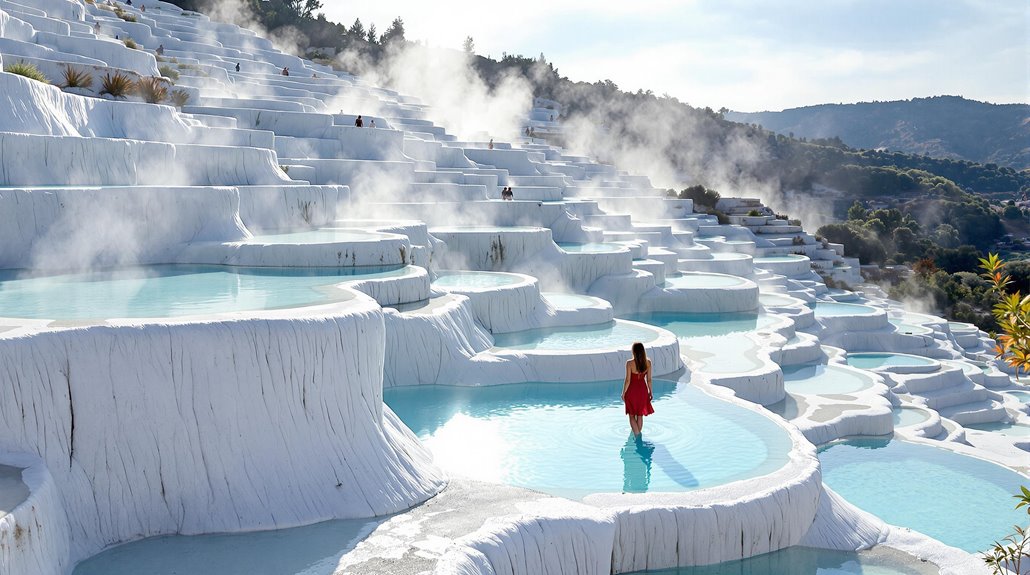
You've probably seen those dreamy photos of white limestone terraces cascading down Turkish hillsides, but Pamukkale offers far more than its famous thermal pools. Whether you're seeking ancient history, natural wonders, or adrenaline-pumping adventures, this UNESCO site delivers unforgettable experiences. From swimming among sunken Roman ruins to soaring over travertine cliffs by paraglider, you'll discover why travelers have been drawn to these healing waters for thousands of years.
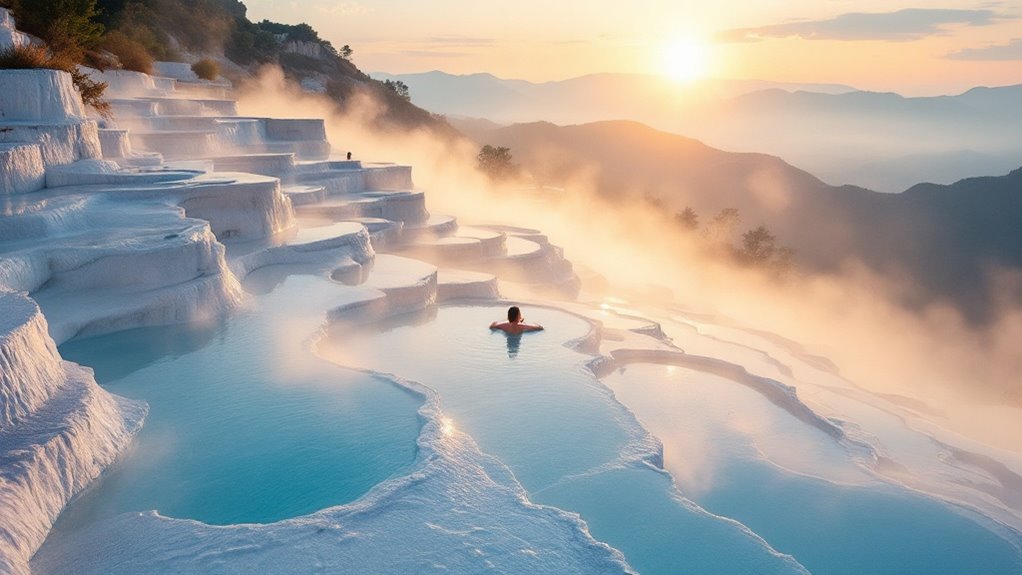
While most visitors flock to Pamukkale's thermal pools during peak hours, arriving at the south entrance by 6:30 AM rewards you with up to an hour of serene bathing before the crowds descend.
You'll find the warmest waters (30-35°C) in the top and bottom pools, perfect for comfortable wading in the cool morning air.
Watch hot air balloons drift overhead as you navigate the slippery travertine surfaces, and enjoy the pools at their fullest before daytime pumping begins.
For the best experience, head to the lower sections, which stay less crowded than the upper areas near the Hierapolis ruins. The soft clay mud inside the pools creates an unusual but memorable walking sensation.
Don't forget you'll need to go barefoot to protect the delicate calcium carbonate formations.
If you want deeper swimming, visit the Cleopatra Antique Pool later – though it requires an additional fee.
Before stepping onto Pamukkale's pristine travertine terraces, you'll discover you need to remove your shoes to protect these delicate natural formations.
Visitors must go barefoot to explore Pamukkale's delicate white terraces, preserving these natural wonders for future generations.
Visitors have been drawn to these stunning formations since ancient Greek times.
As you walk barefoot, you'll experience surfaces ranging from smooth calcium gel to crystallized rock, with water temperatures varying from a comfortable 19°C to a steamy 57°C.
For the best experience, enter through the lower town entrance where crowds are thinner.
The mid-to-lower terraces offer a more peaceful experience than the busy upper pools near Hierapolis.
The snow-white cascading basins, formed over 14,000 years, stretch an impressive 2,700 meters long.
You'll discover the warm mineral water flowing through channels into tiered pools, creating nature's perfect infinity pools.
Visit early morning or late afternoon to avoid peak crowds and fully appreciate these remarkable geological formations.
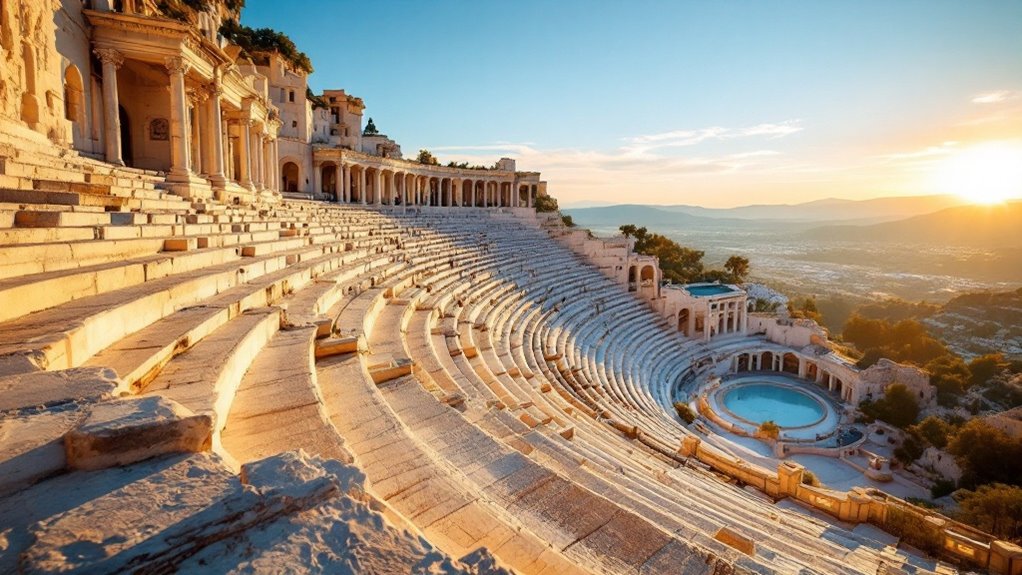
The ancient Roman theater stands as a striking monument above Pamukkale's white terraces, beckoning visitors to explore its rich history.
You'll discover yourself walking through a masterpiece of Roman engineering that once held 15,000 spectators across its marble-lined tiers.
As you climb the well-preserved steps, you'll notice the theater's impressive three-story façade stretching 91 meters wide, decorated with mythological reliefs of Apollo, Dionysus, and Diana.
The stage building, rebuilt under Septimius Severus, features elegant columns and niches that once housed statues of Roman deities and emperors.
The theater was constructed during the reign of Hadrian after 60 AD, following a devastating earthquake that required significant rebuilding.
Don't miss the imperial loge with its distinctive lion-paw carvings.
Thanks to extensive Italian restorations from 2004 to 2014, you can experience this UNESCO World Heritage site much as ancient Romans did during their spa visits to Hierapolis.
Immersed in thermal waters at a constant 36°C, you'll swim through a surreal underwater museum where ancient Roman columns and marble fragments lie scattered across the pool floor.
The mineral-rich "Champagne Water" creates tiny bubbles that cling to your skin as you explore depths ranging from shallow edges to 6-meter sections.
Also known as the Sacred Pool, this site was once a significant part of the ancient city of Hierapolis where people sought healing waters.
You'll need a special ticket beyond the regular Pamukkale entry fee to access this ancient pool.
Visit early morning to avoid crowds and enjoy the clearest views of the submerged ruins.
Remember, you can't use sunscreen to protect the water quality, and touching the artifacts is prohibited.
The site provides changing rooms and lockers, plus there's a restaurant overlooking the pool where you can relax after your therapeutic swim through history.
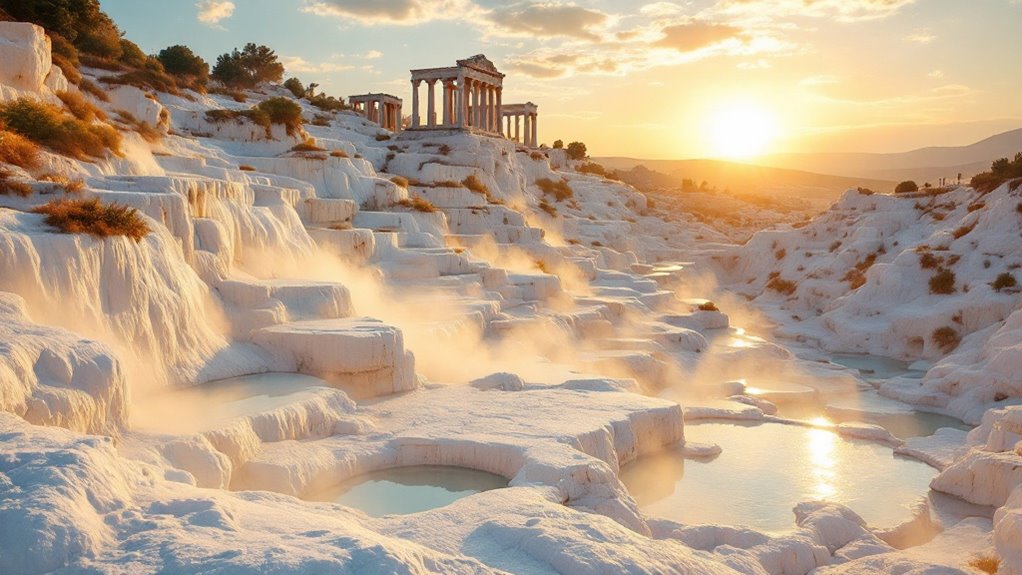
Want to capture Pamukkale's ethereal beauty at its peak? Time your visit during golden hour, when the setting sun transforms the white travertines into a magical landscape.
Keep in mind that weather conditions affect the intensity and quality of golden hour light, so check the forecast before planning your shoot.
Arrive 45 minutes before sunset to set up your equipment and scout the perfect spot.
Bring a tripod for stability in low light and use wide-aperture lenses for stunning portraits against the glowing backdrop. You'll want to shoot in RAW format to preserve all the rich details.
Position yourself or your subjects against the sun for dramatic rim lighting and silhouettes, or use the thermal pools' reflections to double the golden magic.
Don't forget to bracket your exposures and use ND filters when shooting directly into the sun.
As light fades, gradually adjust your ISO to maintain clear shots without noise.
On the lookout for the ultimate perspective on Pamukkale's cotton-white terraces? Take to the skies in a hot air balloon at sunrise for an unforgettable 60-75 minute flight.
You'll drift silently above the stunning travertines and ancient Hierapolis ruins while your pilot shares fascinating historical insights.
Standard flights start at €65 per person, including hotel transfers and a celebratory champagne toast. Professional pilots ensure safety during your journey with extensive flight hours.
You'll join 16-24 fellow adventurers, or opt for a private basket for a more exclusive experience. The total excursion takes about two hours, with flights departing at 5:30 AM in summer or 7:00 AM in winter.
Don't forget to wear closed-toe shoes and layers for the cool morning air.
Bring your camera with a secure strap – you'll want to capture the magical golden hour lighting over the gleaming white terraces.
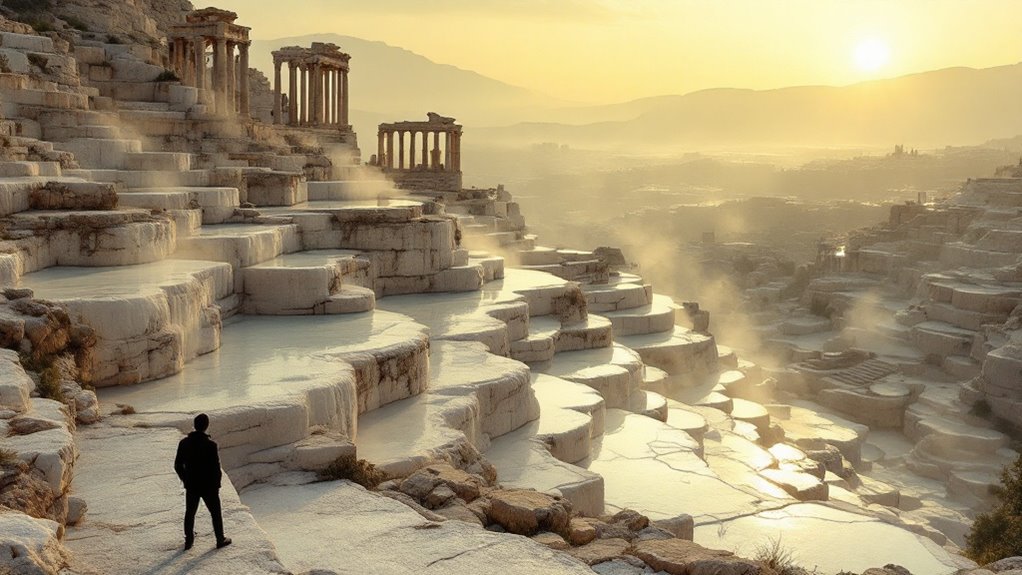
Step back in time as you enter Hierapolis' Northern Necropolis, one of Turkey's largest ancient burial grounds spanning over 2 square kilometers.
Journey through Hierapolis' vast Northern Necropolis, an ancient cemetery stretching across two kilometers of Turkish countryside.
You'll discover over 1,200 cataloged tombs featuring intricate carvings of mythological scenes and funerary banquets, crafted from local travertine and marble.
Data-driven research confirms that this necropolis is among the most extensively documented archaeological sites in Asia Minor. As you explore this ancient city of the dead, you'll encounter:
Don't miss the recently uncovered Iron Age settlements beneath the necropolis, which predate Greek colonization.
The site attracts millions of visitors annually, combining seamlessly with Pamukkale's famous travertine terraces for an unforgettable historical experience.
Beyond the necropolis lies Hierapolis's most mysterious attraction – the infamous Gateway to the Underworld. This ancient temple to Pluto sits atop a natural cave system that emits lethal concentrations of CO₂, making it a genuinely dangerous marvel of both geology and archaeology.
You'll see the restored temple complex where ancient priests performed death-defying rituals, sacrificing animals while spectators watched from safe distances. The site was active until the fourth century CE, with occasional pilgrimages continuing for two hundred years after.
The site features discovered marble statues of Cerberus and serpents, traditional guardians of the underworld. While you can't enter the active gas zones today, you'll learn about the fascinating ceremonies and natural phenomena that earned this site its reputation as a portal to Hades' domain.
The gateway's strategic position on a seismic fault line continues to release the same toxic gases that awed ancient visitors.
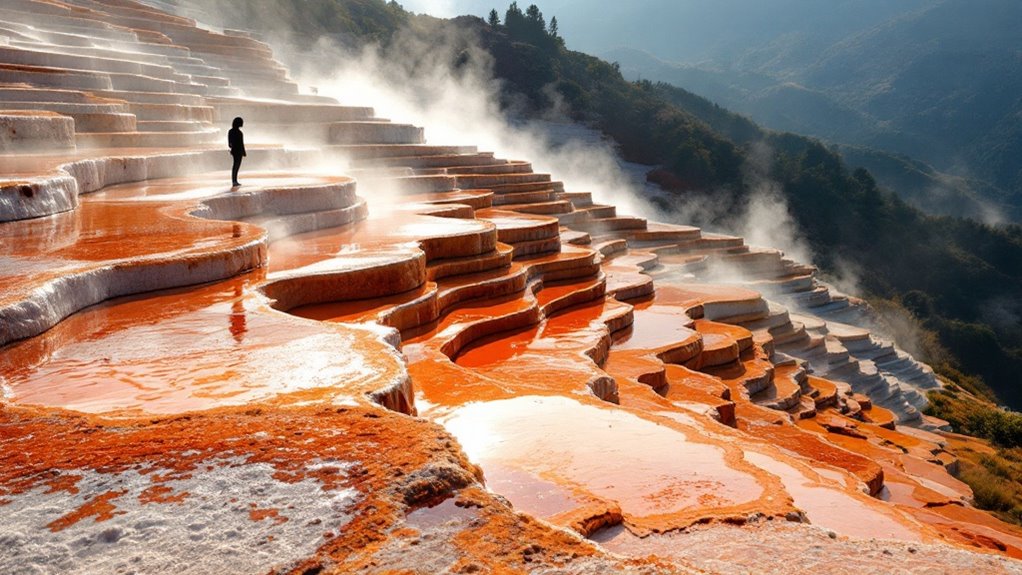
Just a few kilometers from Pamukkale's white terraces, you'll discover the striking red travertines of Karahayıt, where iron-rich thermal waters create an otherworldly landscape of rust-colored mineral formations.
Known locally as Kırmızı Su (Red Water), these unique terraces emerge from 58°C springs, offering therapeutic benefits through their mineral-rich waters. The waters are particularly effective in treating rheumatism and sciatica, making it a popular destination for health tourism.
For the best experience at Karahayıt's red travertines:
Remember to follow conservation guidelines, as these remarkable formations are under UNESCO protection.
To immerse yourself fully in Pamukkale's thermal wonders, you'll discover an impressive selection of spa hotels offering mineral-rich spring waters right in your room.
Top-rated options include Pamukkale Whiteheaven Suite Hotel and ADEMPİRA Termal&Spahotel, both offering excellent value under $140 per night. The Whiteheaven Suite Hotel features 21 decorated guestrooms with heated floors and modern amenities.
You can indulge in hot spring baths reaching 106°F at Hierapark, which also features four indoor pools and family-friendly amenities like waterslides.
For luxury seekers, Pam Thermal Hotel Clinic & Spa provides champagne service and private balconies, while Richmond Pamukkale boasts the largest royal suites and complimentary EV charging.
Most properties offer Turkish hammams, mud therapy, and specialized wellness packages.
With wheelchair-accessible rooms and eco-friendly practices, these hotels cater to all travelers while maintaining sustainable operations.
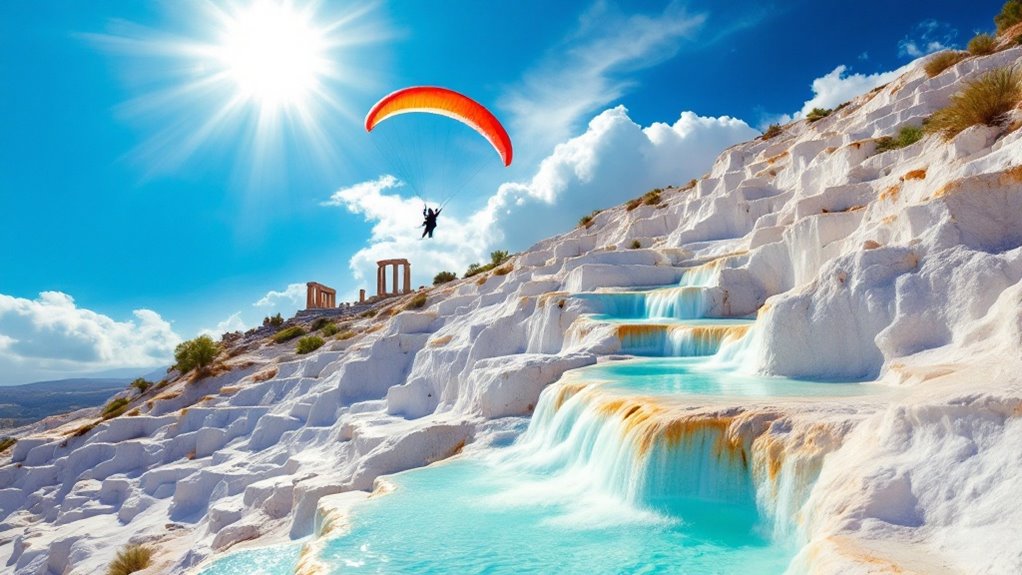
While standing atop Dynamite Hill, you'll experience breathtaking aerial views of Pamukkale's limestone terraces during a tandem paragliding flight lasting 15-45 minutes.
Your licensed pilot handles all navigation while you glide silently above the UNESCO World Heritage site, capturing unique perspectives of ancient Hierapolis and Cleopatra's Pool. From your soaring vantage point, you can reach heights of up to 1,000 meters altitude.
Float peacefully above ancient ruins as your expert guide navigates panoramic views of Hierapolis and its historic thermal pools.
For the best experience:
Free hotel transfers make this adventure accessible, though you'll need to meet basic requirements: weigh under 120kg, be at least 6 years old, and have no serious health conditions or mobility issues.
You will discover Pamukkale offers an unmatched mix of adventure and relaxation. Whether you're soaking in thermal pools, exploring ancient ruins, or paragliding over white terraces, this UNESCO site delivers unique experiences. Don't miss the red travertines at Karahayıt or the chance to swim among Roman columns. For the best value, book an overnight stay at a thermal hotel and catch both sunrise and sunset views.